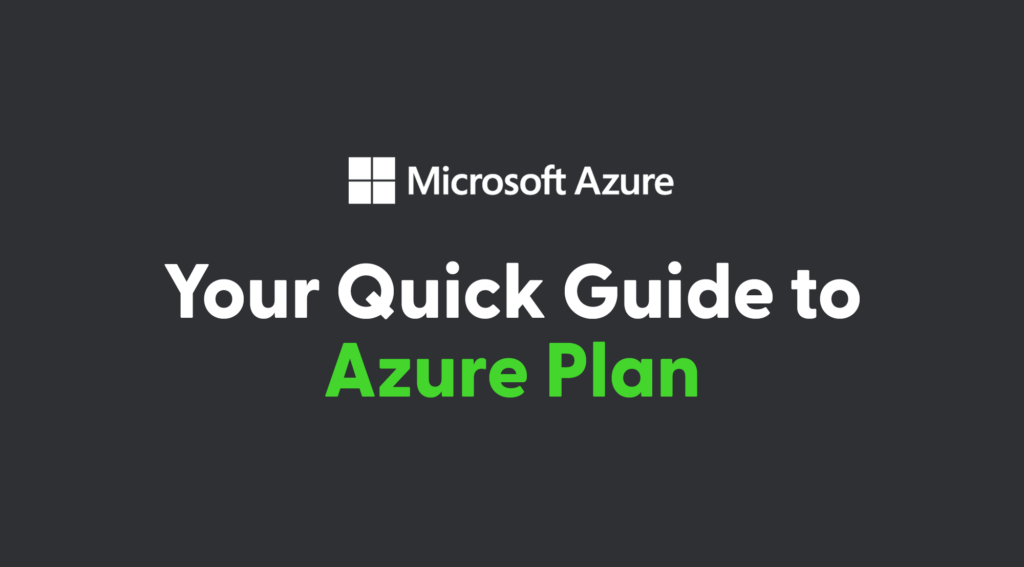Understanding Microsoft Azure Pricing Models
Microsoft Azure offers several pricing models to accommodate diverse user needs and budget considerations. The primary models include pay-as-you-go, reserved instances, and Azure Hybrid Benefit. Understanding these options is crucial for optimizing cloud spending within your Microsoft Azure plan.
The pay-as-you-go model is the most flexible, charging users only for the resources they consume. This model is ideal for unpredictable workloads, development environments, and short-term projects. There is no upfront commitment; resources are billed hourly or even per second, offering granular control over costs. However, for consistent, long-term workloads, the pay-as-you-go model can be the most expensive option compared to other microsoft azure plan options. Reserved Instances provide significant cost savings for predictable workloads. By committing to a one-year or three-year term, users can obtain substantial discounts on virtual machines, databases, and other Azure services. Reserved Instances are best suited for production environments and applications with consistent uptime requirements. The discount applies even if the reserved instance is not fully utilized, making it a valuable component of your microsoft azure plan.
Azure Hybrid Benefit allows customers with existing on-premises Windows Server or SQL Server licenses to use those licenses in Azure, reducing the cost of running virtual machines. This benefit is particularly advantageous for organizations migrating from on-premises environments to the cloud. Factors influencing Azure pricing include the region, instance type, operating system, and usage. Different regions have varying infrastructure costs, which are reflected in the pricing. Instance types, such as general purpose, compute-optimized, or memory-optimized, also impact costs. The operating system, whether Windows or Linux, affects the licensing fees. Finally, the amount of usage, including compute hours, storage consumption, and network bandwidth, directly influences the overall cost of the microsoft azure plan. By carefully considering these factors and choosing the appropriate pricing model, organizations can effectively manage and optimize their Azure spending.
How to Choose the Right Azure Subscription for Your Needs
Selecting the appropriate Microsoft Azure plan subscription is crucial for aligning cloud resources with business objectives and budgetary constraints. A well-chosen subscription ensures access to necessary services, adequate support levels, and optimal cost management. This step-by-step guide assists in navigating the Azure subscription landscape to identify the best fit for specific organizational needs. Assessing organizational size is paramount. Start-ups and small businesses might find the “Free Trial” or “Pay-As-You-Go” options suitable for initial exploration and development. These options offer limited resources and cost flexibility, allowing businesses to scale as needed. Medium-sized businesses may benefit from the “Microsoft Azure plan” for “Development and Testing” or “Enterprise Agreement” subscriptions, providing a balance between cost, resources, and support. Large enterprises often require the robust features and dedicated support of “Enterprise Agreement” or “Microsoft Customer Agreement” subscriptions, which offer volume discounts and tailored support plans.
Budgetary considerations play a significant role in subscription selection. The “Pay-As-You-Go” model offers flexibility but can lead to unpredictable costs if not carefully monitored. “Reserved Instances” and “Azure Hybrid Benefit” can significantly reduce costs for predictable workloads. The “Azure Free Account” provides a limited set of services for free for 12 months, plus access to always free services, ideal for learning and experimentation. Required services also influence the choice. Evaluate which Azure services are essential for business operations. Subscriptions like “Microsoft Azure plan” for “Students” provide access to specific services relevant to educational purposes. “Azure for Government” offers compliance with specific government regulations and access to services tailored for government agencies. Consider the level of support needed. The “Basic” support plan offers limited support, while “Developer,” “Standard,” and “Professional Direct” plans provide increasing levels of support and service level agreements (SLAs). The “Enterprise Agreement” and “Microsoft Customer Agreement” subscriptions typically include enhanced support options.
Examples of Azure subscriptions and user types include: “Free Trial” suitable for individuals exploring Azure; “Pay-As-You-Go” ideal for startups with fluctuating resource needs; “Development and Testing” perfect for development teams requiring isolated environments; “Enterprise Agreement” designed for large organizations with complex requirements; “Microsoft Azure plan” for “Students” tailored for educational purposes; and “Azure for Government” catering to government entities. By carefully assessing organizational size, budgetary constraints, required services, and support needs, organizations can select the Azure subscription that best aligns with their goals and resources. This strategic approach ensures efficient cloud resource utilization and cost optimization. Each Microsoft Azure plan offers unique advantages, ensuring that businesses can tailor their cloud strategy to their specific operational context.
Comparing Azure Resource Deployment Strategies
Different strategies exist for deploying resources within Microsoft Azure, each offering unique advantages and disadvantages. Understanding these approaches is crucial for organizations seeking to optimize their cloud infrastructure management and implement a robust microsoft azure plan. The Azure portal provides a user-friendly, graphical interface for deploying and managing resources. This method is ideal for smaller deployments or when a visual approach is preferred. However, it can become time-consuming and error-prone for complex infrastructures or when repeatability is required.
The Azure Command-Line Interface (CLI) and PowerShell offer more programmatic approaches. The Azure CLI is a cross-platform command-line tool, while PowerShell provides a scripting environment specifically tailored for Windows-based systems. These tools allow for automation through scripting, which is beneficial for consistent and repeatable deployments. Infrastructure as Code (IaC) tools, such as Azure Resource Manager (ARM) templates and Terraform, represent a more advanced deployment strategy. With ARM templates, users define their infrastructure in a declarative JSON format. Terraform, on the other hand, is an open-source IaC tool that supports multiple cloud providers, including Azure. IaC enables version control, collaboration, and automated deployments, ensuring consistency and reducing the risk of human error. This approach is highly recommended for large-scale deployments and complex environments, providing scalability and maintainability for any robust microsoft azure plan.
Real-world use cases illustrate the strengths of each approach. For a small business setting up a simple web application, the Azure portal might suffice for initial deployment. A development team automating the creation of development and test environments could leverage the Azure CLI or PowerShell scripting. Enterprises deploying complex, multi-tiered applications across multiple regions would benefit significantly from using IaC tools like ARM templates or Terraform. Consider a scenario where a company needs to deploy a highly available web application with load balancers, virtual machines, and databases. Using ARM templates, they can define the entire infrastructure as code, ensuring that each deployment is consistent and repeatable. Furthermore, this approach allows for easy scaling and modification of the infrastructure as the application grows, aligning perfectly with any strategic microsoft azure plan.
Azure Cost Management: Optimizing Your Cloud Spend
Azure Cost Management is an essential suite of tools designed to empower users to effectively monitor, analyze, and optimize their cloud spending. Understanding and leveraging these tools is crucial for maintaining a cost-efficient microsoft azure plan and avoiding unnecessary expenses. The core functionalities revolve around setting budgets, creating alerts, and gaining insights into cost trends to identify areas where savings can be achieved. By diligently utilizing Azure Cost Management, organizations can ensure they are maximizing the value of their cloud investments. This involves understanding your microsoft azure plan cost implications.
A fundamental aspect of Azure Cost Management is the ability to set budgets tailored to specific subscriptions, resource groups, or even individual resources. Once a budget is defined, the system can generate alerts when spending approaches or exceeds the defined threshold. These alerts provide proactive notifications, enabling timely intervention and preventing unexpected cost overruns. Furthermore, Azure Cost Management offers robust analytics capabilities that allow users to dissect their spending patterns. By analyzing cost trends, identifying cost drivers, and pinpointing underutilized resources, organizations can make informed decisions to optimize their microsoft azure plan. This is very important for an efficient microsoft azure plan.
Identifying opportunities for cost savings is a key benefit of using Azure Cost Management. The platform provides recommendations for reducing unnecessary resource consumption, such as identifying idle virtual machines, right-sizing instances, and eliminating orphaned resources. Implementing these recommendations can lead to significant cost reductions without compromising performance or functionality. Consider strategies such as shutting down non-production environments during off-peak hours or leveraging Azure Reserved Instances for predictable workloads. Regularly reviewing and refining your microsoft azure plan based on insights from Azure Cost Management ensures continuous optimization of your cloud spend. Proper management is crucial for a successful microsoft azure plan.
Exploring the Azure Free Tier: What’s Included?
The Microsoft Azure Free Tier offers a fantastic entry point for individuals and organizations eager to explore the power of cloud computing without immediate financial commitment. It’s structured to provide access to a range of Azure services, allowing users to learn, experiment, and even deploy small-scale applications. Understanding its components and limitations is crucial for maximizing its benefits and avoiding unexpected charges. This is an excellent way to start with a microsoft azure plan.
The Azure Free Tier includes two main types of offers: services that are free for 12 months and services that are always free. The 12-month free services typically include a specific amount of compute, storage, and database resources. For example, users often receive a certain number of virtual machine hours, a limited amount of storage in Azure Blob Storage, and a free Azure SQL Database. These offerings are designed to allow users to build and test basic applications. The “always free” services, on the other hand, provide ongoing access to a subset of Azure services without any time limit, although usage restrictions usually apply. These may include services like Azure Functions (with a monthly execution limit), Azure Cosmos DB (with limited storage and throughput), and certain developer tools. These options are designed to always give you a free microsoft azure plan.
While the Azure Free Tier is an attractive option, it’s essential to be aware of its limitations and potential pitfalls. Users should carefully monitor their usage to ensure they stay within the free limits. Exceeding these limits will result in charges at standard pay-as-you-go rates. It’s also important to note that certain services and instance types are not included in the Free Tier. Before deploying any resources, users should consult the official Azure documentation to verify their eligibility for free usage. Furthermore, the Azure Free Tier is typically available only to new Azure customers. Existing customers or those who have previously used a Free Tier subscription may not be eligible. Properly understanding the microsoft azure plan will let you have a better experience in the cloud, and to keep costs down.
Demystifying Azure Reservations: A Cost-Saving Strategy
Azure Reservations offer a significant opportunity to reduce costs for predictable workloads within a microsoft azure plan. They allow organizations to pre-purchase Azure resources, such as virtual machines, SQL databases, and other services, for a term of one or three years. In exchange for this commitment, Microsoft offers a substantial discount compared to pay-as-you-go pricing. This strategy is particularly effective for workloads that run consistently, such as production environments or development/test environments that are always active. By implementing a well-structured microsoft azure plan, organizations can strategically plan and optimize their resource allocation for maximum cost efficiency.
Determining the appropriate reservation size and duration is crucial for maximizing cost savings. Analyze historical usage data to identify resources that are consistently utilized. Consider future growth plans to ensure the reservation adequately covers anticipated needs. The Azure portal provides tools to help estimate potential savings based on historical usage. When purchasing a reservation, organizations need to select the specific resource type, region, and performance tier. It’s important to choose these parameters carefully, as they cannot be changed after the reservation is purchased. However, Azure offers some flexibility, allowing users to exchange reservations for other instance sizes within the same instance size family. Properly planning a microsoft azure plan can also include utilizing these reservations for optimal savings. Careful planning is important when creating your microsoft azure plan.
The process of purchasing and managing reservations is straightforward through the Azure portal. Navigate to the “Reservations” section and select the desired resource type. Specify the required parameters, such as region, instance size, and quantity. Review the estimated cost savings and confirm the purchase. The Azure portal also provides tools for managing existing reservations. Organizations can track utilization, modify the scope of the reservation (e.g., applying it to a specific resource group or subscription), and exchange or refund reservations if needed. Note that refunds may be subject to certain limitations and fees. Real-world examples demonstrate the potential cost savings. For instance, a company running a SQL database 24/7 can save up to 70% by purchasing a reserved instance compared to paying the standard rate. Implementing Azure Reservations within a comprehensive microsoft azure plan is a proven strategy for optimizing cloud spend and achieving significant cost reductions. A well thought out microsoft azure plan will always take reservations into account.
Azure Support Options: Getting Help When You Need It
Microsoft Azure offers a range of support plans designed to meet diverse needs, ensuring users receive timely assistance. Understanding these options is crucial for maintaining optimal performance and resolving issues efficiently. The available plans include Basic, Developer, Standard, and Professional Direct, each offering varying levels of support and features. Choosing the right plan depends on factors such as business criticality, technical expertise, and budget constraints. A well-considered microsoft azure plan will incorporate the appropriate support tier.
The Basic support plan is included for all Azure customers and provides access to online self-help documentation, community forums, and billing support. It’s suitable for users who primarily require self-service resources and have limited support needs. The Developer support plan is designed for non-production environments and offers business hours email support. It’s ideal for developers and testers who need assistance with technical issues but don’t require immediate response times. The Standard support plan provides 24/7 access to technical support via email and phone with a faster response time than the Developer plan. This is a good option for production workloads where timely assistance is critical. Professional Direct offers the highest level of support, including a dedicated technical account manager (TAM) and proactive guidance. This plan is designed for mission-critical applications and enterprises with complex Azure deployments. Each microsoft azure plan has specific service level agreements (SLAs) that define response times.
Submitting a support request through the Azure portal is a straightforward process. Navigate to the “Help + support” section, select “New support request,” and provide detailed information about the issue. Clearly describe the problem, including any error messages, steps to reproduce the issue, and the impact on your services. Include relevant logs, screenshots, and other diagnostic data to help the support team quickly understand and resolve the problem. When drafting your microsoft azure plan, consider including guidance for your team on creating effective support requests. In addition to paid support plans, Microsoft Azure has a vibrant community of users and experts who offer assistance through forums, blogs, and social media channels. These community resources can be valuable for finding solutions to common problems and learning from others’ experiences. Utilizing both formal support plans and community resources ensures comprehensive support coverage for your Azure environment. Remember to periodically review your support plan to ensure it aligns with your evolving needs and workload requirements. A well-structured support strategy is an integral part of any robust microsoft azure plan.
Migrating to an Azure Cloud Solution: Planning for Success
Migrating to a Microsoft Azure plan requires careful planning to ensure a smooth and successful transition. This involves a thorough assessment of your current infrastructure, selecting the appropriate migration strategy, and addressing security and compliance concerns. A well-defined microsoft azure plan minimizes disruption and maximizes the benefits of cloud adoption. Careful consideration of these aspects is critical for a seamless migration process to a microsoft azure plan.
The initial step involves a comprehensive evaluation of your existing IT infrastructure. Identify all servers, applications, databases, and network components. Determine their dependencies and resource requirements. This assessment helps you understand the scope of the migration and identify potential challenges. Next, choose the right migration strategy. Common strategies include “lift and shift,” re-platforming, and re-architecting. “Lift and shift” involves migrating applications to Azure with minimal changes. Re-platforming involves making minor modifications to applications to take advantage of Azure’s capabilities. Re-architecting involves completely redesigning applications for the cloud. The choice depends on factors like application complexity, budget, and desired level of cloud optimization. Another key consideration is security and compliance. Ensure your microsoft azure plan meets your organization’s security policies and regulatory requirements. Implement appropriate security controls, such as network segmentation, identity management, and data encryption. Address compliance requirements related to data privacy, industry regulations, and geographic location. A solid microsoft azure plan should incorporate robust security measures.
Data migration is a critical aspect of any cloud migration project. Develop a detailed data migration plan that outlines how data will be moved to Azure. Consider factors like data volume, transfer speed, and data integrity. Azure offers several tools for data migration, including Azure Migrate and Azure Database Migration Service. These tools help automate the migration process and minimize downtime. Application modernization may be necessary to fully leverage the benefits of Azure. Consider modernizing your applications to take advantage of cloud-native services. This can improve scalability, performance, and cost-efficiency. Change management is also essential for a successful migration. Communicate the changes to your stakeholders and provide adequate training. Ensure your team has the skills and knowledge to manage the new Azure environment. By following these best practices, organizations can successfully migrate to Azure and realize the full potential of cloud computing. A well-executed microsoft azure plan paves the way for innovation, agility, and cost savings.



